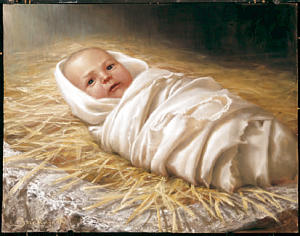Hebrew Word Study: Swaddling Clothes
Luke 2:7, “And she brought forth her firstborn son, and wrapped him in swaddling clothes, and laid him in a manger; because there was no room for them in the inn.”
Ezekiel 16:3-4, “And say, Thus saith the Lord GOD unto Jerusalem; Thy birth and thy nativity [is] of the land of Canaan; thy father [was] an Amorite, and thy mother a Hittite. And [as for] thy nativity, in the day thou wast born thy navel was not cut, neither wast thou washed in water to supple [thee]; thou wast not salted at all, nor swaddled at all.”
 Only Luke talks about Jesus being wrapped in swaddling clothes. Had it not been for this passage in Luke most of us would never have heard of the practice of wrapping a baby in swaddling clothes. This was a practice that would eventually die away around the sixteenth century as it was considered either too barbaric or it really served no practical purpose at all. It was just a tradition that continued for no other reason than the fact it was tradition. It is even believed by many medical specialists to be harmful to the child.
Only Luke talks about Jesus being wrapped in swaddling clothes. Had it not been for this passage in Luke most of us would never have heard of the practice of wrapping a baby in swaddling clothes. This was a practice that would eventually die away around the sixteenth century as it was considered either too barbaric or it really served no practical purpose at all. It was just a tradition that continued for no other reason than the fact it was tradition. It is even believed by many medical specialists to be harmful to the child.
I know as a child I would hear this utterly strange expression, swaddling clothes. It was an expression that was never used at any time except when we would hear the Christmas story and I would wonder what the blazes are swaddling clothes. The usual answer was that it was just a Bible term for blankets or diapers. Swaddling clothes in the Aramaic is azrura which really means a bandage. The Greek word that is used is esparganosen which is the Greek word for a bandage. We have the word swaddling used in Ezekiel 16:3. The Hebrew word used here is chatal which is the Hebrew word for a bandage. I believe it is safe to say that this was more than just a diaper or a blanket.
The practice of swaddling is a very ancient practice. It is believed to have been devised around the Paleolithic times about 4500 years ago during the Bronze Age around 2600 BC. Archaeologists have uncovered little models of babies wrapped in swaddling clothes dating back to this period. After an infant was born the umbilical cord was cut and tied. In this case, as there was no midwife, either Mary or Joseph would have had to do this. They would then sprinkle the baby with a powder made of dried myrtle leaves. Then they would gently rub the baby’s skin with a very small amount of salt that has been finely grounded into a sort of mortar. It was believed this would make his or her flesh firm. For young Jewish parents, this represented a testimony that the parents would raise the child to be truthful and faithful.
Would you like Chaim Bentorah as your personal Hebrew teacher?
|
|
The swaddling clothes were a square yard of cloth that had a narrow band attached at one corner. The mother would wrap the child in this swaddle with its arms close to its body and its legs stretched out. She would then wind the narrow band around the body from the shoulders to the ankles until the poor little beggar looked like an Egyptian mummy. This little ritual was performed as often as we would change a diaper today and would be done until the child was potty trained. In a practical sense, it was meant to help the bodies grow strong and firm. It is interesting that today medical science has learned that it is best just to leave the poor chap alone, that he will develop naturally without artificial help. It took four thousand years for man to realize that God did a perfectly fine job creating the human creature without artificial intervention. To the Jewish parent, however, this practice carried symbolic meaning, of course, every practice in Judaism carries some symbolism. This was a sign to the parents that they would teach the child to become honest, straightforward, and freed from crookedness.
This brings up the question as to why Luke felt it was important to mention this, not once, but two times, again in verse 12 where the angel tells the shepherds that the child will be found wrapped in swaddling clothes. I mean, big whip, if every baby is wrapped in swaddling clothes just how were the shepherds able to use that to distinguish Jesus from any other baby coming down the pike? That is like going into an Amish community and asking to speak to Mr. Miller. Odds are every other male is a Mr. Miller.
Some say that Luke mentioned this because he was a physician and thus concerned about these details. Obvious, he was nothing close to the skills, education, and training of a physician today and it is a very poor comparison indeed. Colossians 4:14 called him the beloved physician in our English versions. The Greek word used is iatros which most of your lexicons will say, means physician. Although the practice of medicine existed in the first century it was not the skill, education, or training of the physician we have and think of today. The Aramaic word used in Colossians 4:14 is assia which is really a healer. An assia is not a surgeon, physician or dispenser of medicine as was practiced during this time among the Greeks and Romans. An assia was more of a chiropractor who adjusted joints and dislocated bones. He would have been a practitioner of a holistic form of healing. Such practices were professions that were handed down from father to son with no formal medical training nor did they depend upon the practice for a living. So I doubt very much that Luke mentioned the swaddling from a professional standpoint.
More likely he mentioned it from the standpoint of a practitioner of spiritual values rather than medical skills. Luke would have been familiar with the passage in Ezekiel 16:4 where the prophet refers to this custom in his prophecy. In Ezekiel 16 the prophet is speaking out against the citizens of Jerusalem who were unfaithful to God and His commandments and uses the symbolic reference of washing, salting, and swaddling. Failing to perform this tradition was symbolic of disloyalty and unfaithfulness to God. The term swaddling clothes to the Semitic mind was expressing the idea of loyalty and faithfulness to God. Thus, Luke wanted to make sure that this child that was born was not only the Son of God but a Son who would be loyal and faithful to Heavenly Father. So loyal and faithful in fact that He would be one with the Heavenly Father.
Hi there! Thank you for reading this Daily Word Study. Can I ask a favor? Share this Daily Word Study with your friends on Facebook and Twitter by clicking one of the icons below.
Thanks & Blessings, it means a lot to me!







Did the priests at the Jerusalem temple send out specialized priests to sieze and swaddle to protect the “perfect , unblembished lamb ” for sacrifice later in its life ?
I’d been taught that swaddling clothes were what people carried with them traveling, JUST in case they died on their journey. Then there would be less bother to someone looking after the body. And how fitting was that , that the son of God died for us all and as he’s born he’s wrapped in death cloth.
Have you heard this? what’s your take on it?
Babies are still swaddled today for the first few months as a way to comfort them.
Fascinating. Imagine keeping bandages in a barn. I have been swayed for years that swaddling clothes were unmistakably linked with death – a far more common occurrence in those cultures as history attests. A baby signified as such would be unique by any reasonable standard. To those of us who believe in a babe “born to die”, nothing could be more clear.
Swaddling is still a somewhat accepted practice. It goes in and out of style as a way to soothe the baby. One needs to be careful doing it, but it’s not quite so outrageous as you think. And one need not denigrate Luke’s knowledge. There were herbalists in those days.
Blessings and happy holidays!
Do you mean a baby with swaddled until he was potty trained at the age of two or three?l. I seriously doubt that interpretation.
You might want to re-read it.
I re read it and that is what it sounds like
I encountered the Ezekiel use for the first time this year and appreciated the clear distinction between the un-swaddled, un-purified (salted) and uncared for child and the cared for Son of Mary, Son of God. I had not understood the traditional parental commitment to straightness and I appreciate that insight. I did read that the shepherds of the sacrificial lambs would bind their legs for straightness but I haven’t sourced that yet.
The other one I was drawn to this year was Job 38:9 where God sets the darkness as the limit on the sea as a “swaddling band” חֲתֻלָּה
So the great power of the eternal son is swaddled into the body of a child and set his human limits.
The other thing have I heard re the bandages was that travellers on the road would wind linens around their bodies in case someone died on the journey. And that similar linens would be kept in alcoves in caves at the town limits so anyone that died during festivals could be wrapped till they could be dealt with. I don’t know how true that is but if Yeshua was swaddled with a winding cloth that would certainly be a sign.
I’ve heard that the swaddling was symbolic of what was done to newborn lambs to protect them from any bruising etc. until they were inspected for “perfection”. They (the lambs) were laid in a “manger” after being swaddled in cloth. All this foretelling Christ as the sacrificial, perfect lamb.